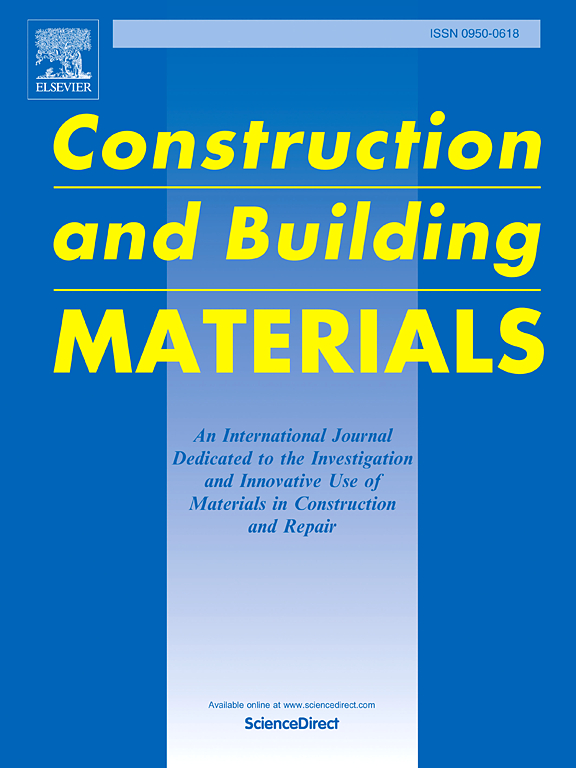Development of an enhanced double-layer hydrophobic system for wood via MTMS cross-linking, lumen filling and MTCS surface treatment
IF 7.4
1区 工程技术
Q1 CONSTRUCTION & BUILDING TECHNOLOGY
引用次数: 0
Abstract
The widespread application of fast-grown timber species is hindered by their high susceptibility to water absorption, poor dimensional stability, and inadequate mechanical strength. In this study, poplar wood underwent a sequential impregnation process with methyltrimethoxysilane (MTMS) and an ammonia-ethanol mixture. This combined treatment allowed silane cross-linking with cell walls while also filling wood cavities, promoting the in-situ growth of nanoparticles. After the impregnation process, a subsequent surface treatment with methyltrichlorosilane (MTCS) was then performed to establish a hydrophobic surface layer. Through structural and surface modification, a novel double-layer hydrophobic system was constructed to enhance water resistance. The modified wood exhibits a surface water contact angle of 153.6° ± 0.5° and a 10-mm depth contact angle of 112.8° ± 0.6°, illustrating the effectiveness of the dual-layer hydrophobic structure. Compared to the control wood, the modified samples exhibited a 65.6 % reduction in 24 h water absorption and a 48.4 % decrease in volume swelling. Additionally, cross-linking and lumen filling considerably improved the mechanical properties of the modified wood. The double-layer hydrophobic system shows significant potential to extend the service life of wood and enhance its mechanical performance, paving the way for broader applications in moisture-sensitive environments.
通过MTMS交联、管腔填充和MTCS表面处理,增强木材双层疏水系统的开发
速生木材的广泛应用受到其吸水率高、尺寸稳定性差和机械强度不足的阻碍。在本研究中,杨木采用甲基三甲氧基硅烷(MTMS)和氨-乙醇混合物序贯浸渍工艺。这种组合处理允许硅烷与细胞壁交联,同时也填充木腔,促进纳米颗粒的原位生长。浸渍后,用甲基三氯硅烷(MTCS)进行表面处理,建立疏水表面层。通过结构和表面改性,构建了一种新型的双层疏水体系。改性木材的表面水接触角为153.6°± 0.5°,10-mm深度接触角为112.8°± 0.6°,说明了双层疏水结构的有效性。与对照木相比,改性后的木材24 h吸水率降低了65.6% %,体积膨胀率降低了48.4% %。此外,交联和管腔填充显著改善了改性木材的机械性能。双层疏水系统在延长木材的使用寿命和提高其机械性能方面显示出巨大的潜力,为在潮湿敏感环境中更广泛的应用铺平了道路。
本文章由计算机程序翻译,如有差异,请以英文原文为准。
求助全文
约1分钟内获得全文
求助全文
来源期刊

Construction and Building Materials
工程技术-材料科学:综合
CiteScore
13.80
自引率
21.60%
发文量
3632
审稿时长
82 days
期刊介绍:
Construction and Building Materials offers an international platform for sharing innovative and original research and development in the realm of construction and building materials, along with their practical applications in new projects and repair practices. The journal publishes a diverse array of pioneering research and application papers, detailing laboratory investigations and, to a limited extent, numerical analyses or reports on full-scale projects. Multi-part papers are discouraged.
Additionally, Construction and Building Materials features comprehensive case studies and insightful review articles that contribute to new insights in the field. Our focus is on papers related to construction materials, excluding those on structural engineering, geotechnics, and unbound highway layers. Covered materials and technologies encompass cement, concrete reinforcement, bricks and mortars, additives, corrosion technology, ceramics, timber, steel, polymers, glass fibers, recycled materials, bamboo, rammed earth, non-conventional building materials, bituminous materials, and applications in railway materials.
 求助内容:
求助内容: 应助结果提醒方式:
应助结果提醒方式:


